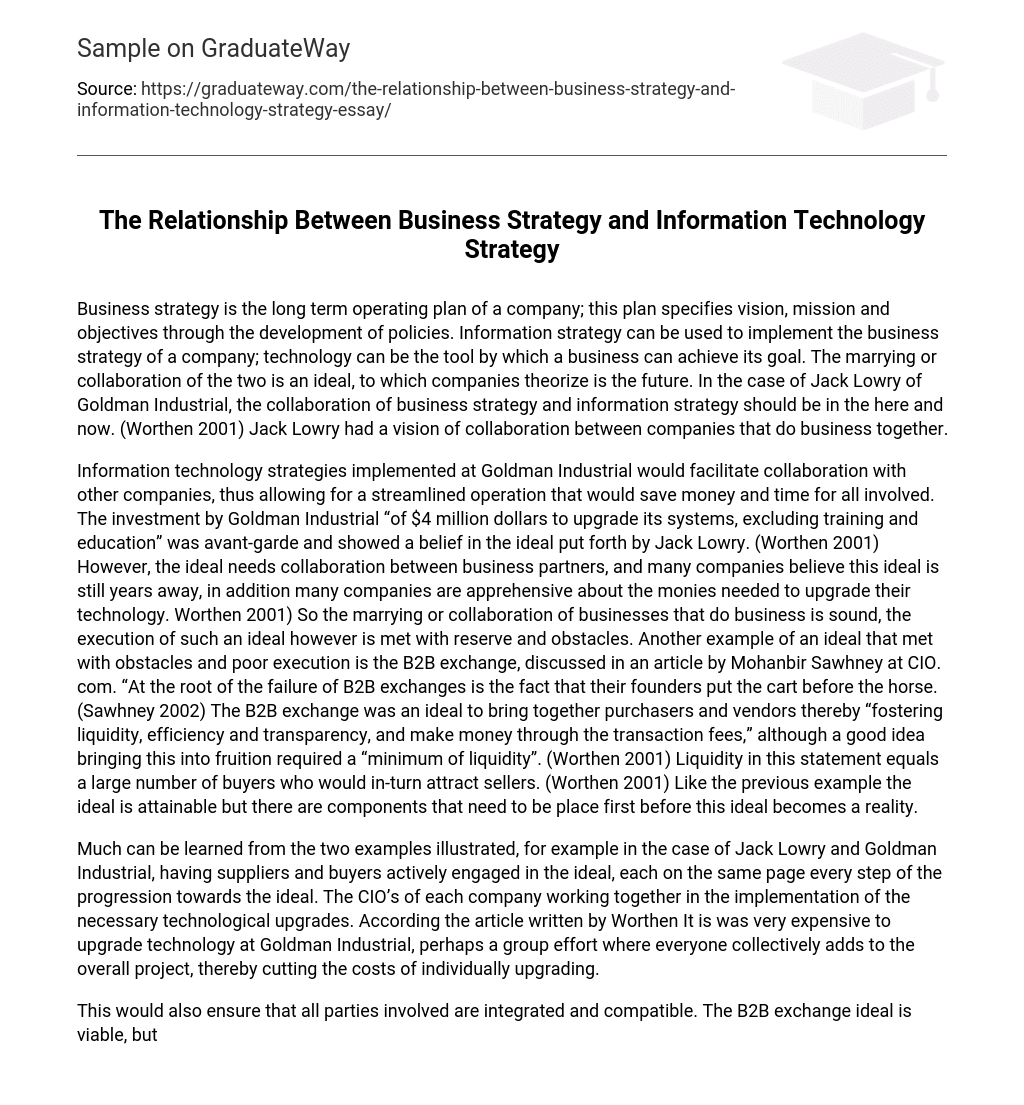Business strategy is the long term operating plan of a company; this plan specifies vision, mission and objectives through the development of policies. Information strategy can be used to implement the business strategy of a company; technology can be the tool by which a business can achieve its goal. The marrying or collaboration of the two is an ideal, to which companies theorize is the future. In the case of Jack Lowry of Goldman Industrial, the collaboration of business strategy and information strategy should be in the here and now. (Worthen 2001) Jack Lowry had a vision of collaboration between companies that do business together.
Information technology strategies implemented at Goldman Industrial would facilitate collaboration with other companies, thus allowing for a streamlined operation that would save money and time for all involved. The investment by Goldman Industrial “of $4 million dollars to upgrade its systems, excluding training and education” was avant-garde and showed a belief in the ideal put forth by Jack Lowry. (Worthen 2001) However, the ideal needs collaboration between business partners, and many companies believe this ideal is still years away, in addition many companies are apprehensive about the monies needed to upgrade their technology. Worthen 2001) So the marrying or collaboration of businesses that do business is sound, the execution of such an ideal however is met with reserve and obstacles. Another example of an ideal that met with obstacles and poor execution is the B2B exchange, discussed in an article by Mohanbir Sawhney at CIO. com. “At the root of the failure of B2B exchanges is the fact that their founders put the cart before the horse. (Sawhney 2002) The B2B exchange was an ideal to bring together purchasers and vendors thereby “fostering liquidity, efficiency and transparency, and make money through the transaction fees,” although a good idea bringing this into fruition required a “minimum of liquidity”. (Worthen 2001) Liquidity in this statement equals a large number of buyers who would in-turn attract sellers. (Worthen 2001) Like the previous example the ideal is attainable but there are components that need to be place first before this ideal becomes a reality.
Much can be learned from the two examples illustrated, for example in the case of Jack Lowry and Goldman Industrial, having suppliers and buyers actively engaged in the ideal, each on the same page every step of the progression towards the ideal. The CIO’s of each company working together in the implementation of the necessary technological upgrades. According the article written by Worthen It is was very expensive to upgrade technology at Goldman Industrial, perhaps a group effort where everyone collectively adds to the overall project, thereby cutting the costs of individually upgrading.
This would also ensure that all parties involved are integrated and compatible. The B2B exchange ideal is viable, but not as a main focus, more like an offshoot of already available business processes. (Sawhney 2002) An example of this is the company Celarix mentioned in the CIO. com article. “Celarix engages in collaborative logistics and at the early stage of its business strategy had two goals one was to match vendors with customers; the other was to supply software that would allow for the overseeing of all matters dealing with transportation. (Sawhney 2002) According to the article, Celarix, as it grew realized it needed to concentrate on specific areas and they chose “software and services like system integration. (Sawhney 2002) According to the article by Worthen, “Goldman’s position near the bottom of the supply chain puts the company in a poor spot to steer changes within the industry. ” (2001) The lessons to take away from pioneers like Jack Lowry and Goldman Industrial should include, the participation of the vendors and sellers in regards to the upgrading of their technology as well as the input and/or consensus of the CIO’s of the respective companies.
The good news for Goldman Industrial and Jack Lowry is that the costly upgrade of technology is paying for itself in the realization of savings, he “estimates saving $700,000 because of reduced cycle times and increased sales through the e-commerce site in the first 18 months alone. ” (Worthen 2001) Celarix realized through trial and error after their initial business strategy was not working to concentrate their efforts in two specific areas of software and transportation. “Celarix now sees the logistics marketplace as a byproduct of the software and solutions business, and not its main focus. (Sawhney 2002) Business strategy and information strategy need not be opposing forces. Using the experiences of Goldman Industrial and Celarix as blueprints of what not to do, and building upon the bright spots of information strategy, like the cost savings of Goldman Industrial or the reworking of how best to use information strategy like Celarix, is the direction toward the marrying or collaboration of both business and information strategies as an ideal, is worth attaining.
References Sawhney, Mohanbir. (2002) B2B: Execution of the Concept Is Key to Success. CIO. com Retrieved January 24, 2010 from http://www. cio. com/article/31078/B2B_Execution_of_the_Concept_Is_Key_to_Success Worthen, Ben. (2001) Collaborative Computing and True Enterprise Architecture Is Still Two Years Away. CIO. com Retrieved January 24, 2010 from http://www. cio. com/article/30605/COLLABORATIVE_COMPUTING_and_True_Enterprise_Architecture_Is_ Still_Two_Years_Away





